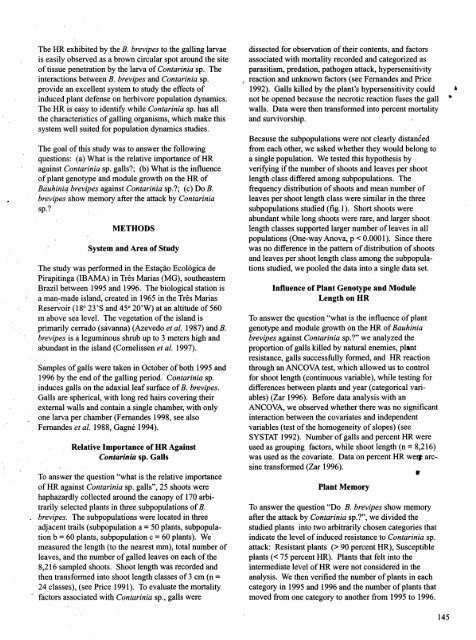il ' ii - Northern Research Station - USDA Forest Service
il ' ii - Northern Research Station - USDA Forest Service
il ' ii - Northern Research Station - USDA Forest Service
Create successful ePaper yourself
Turn your PDF publications into a flip-book with our unique Google optimized e-Paper software.
The HR exhibited by the B. brevipes to the galling larvae dissected for observation of their contents, and factors<br />
is eas<strong>il</strong>y observed as a brown circular spot around the site associated with mortality recorded and categorized as<br />
of tissue penetration by the larva of Contarinia sp. The parasitism, predation, pathogen attack, hypersensitivity<br />
interactions between B. brevipes and Contarinia sp. : reaction and unknown factors (see Femandes and Price<br />
provide an excellent system to study the effects of 1992). Galls k<strong>il</strong>led by the plant's hypersensitivity could A<br />
induced plant defense on herbivore population dynamics, not be opened because the necrotic reaction fuses the gall "<br />
The HR is easy to identify wh<strong>il</strong>e Contarinia sp. has all walls. Data were then transformed into percent mortality<br />
the characteristics of galling organisms, which make this and survivorship.<br />
system well suited for population dynamics studies.<br />
Because the subpopulations were not clearly distanded<br />
The goal of this study was to answer the following from each other, we asked whether they would belong to<br />
questions: (a) What is the relative importance of HR a single population. We tested this hypothesis by<br />
against Contarinia sp. galls?; (b) What is the influence verifying if the number of shoots and leaves per shoot<br />
of plant genotype and module growth on the HR of length class differed among subpopulations. The<br />
Bauhinia brevipes against Contarinia sp.?; (c) Do B. frequency distribution of shoots and mean number of<br />
, brevipes show memory after the attack by Contarinia leaves per shoot length class were sim<strong>il</strong>ar in the three<br />
sp.? subpopulations studied (fig. 1). Short shoots were<br />
abundant wh<strong>il</strong>e long shoots were rare, and larger shoot<br />
METHODS length classes supported larger number of leaves in all<br />
populations (One-way Anova, p < 0.0001). Since there<br />
System and Area of Study was no difference in the pattern of distribution of shoots<br />
and leaves per shoot length class among the subpopula-<br />
The study was performed in the Estaq_o Ecolrgica de tions studied, we pooled the data into a single data set.<br />
Pirapitinga (IBAMA) in Trrs Marias (MG), southeastern<br />
Braz<strong>il</strong> between 1995 and 1996. The biological station is Influence of Plant Genotype and Module<br />
. a man-made island, created in 1965 in the Tr_s Marias Length on HR<br />
ReSelwoir (18° 23'S and 45° 20'W) at an altitude of 560<br />
m above sea level. The vegetation of the island is To answer the question "what is the influence of plant<br />
primar<strong>il</strong>y cerrado (savanna) (Azevedo et al. 1987) and B. genotype and module growth on the HR of Bauhinia<br />
brevipes is a leguminous shrub up to 3 meters high and brevipes against Contarinia sp.?" we analyzed the<br />
abundant in the island (Comelissen et al. 1997). proportion of galls k<strong>il</strong>led by natural enemies, plant<br />
resistance, galls successfully formed, and HR reaction<br />
Samples of galls were taken in October of both 1995 and through an ANCOVA test, which allowed us to control<br />
1996 by the end of the galling period. Contarinia sp. for shoot length (continuous variable), wh<strong>il</strong>e testing for<br />
induces galls on the adaxial leaf surface of B. brevipes, differences between plants and year (categorical vari-<br />
Galls are spherical, with long red hairs coveting their ables) (Zar 1996). Before data analysis with an<br />
external wa!ls and contain a single chamber, with only ANCOVA, we observed whether there was no significant<br />
one larva per chamber (Fernandes 1998, see also interaction between the covariates and independent<br />
Femandes et al. 1988, Gagn6 1994). variables (test of the homogeneity of slopes) (see<br />
SYSTAT 1992). Number of galls and percent HR were<br />
Relative Importance of HR Against used as grouping factors, wh<strong>il</strong>e shoot length (n = 8,216)<br />
Contarinia sp. Galls was used as the covariate. Data on percent HR we_ arc-<br />
•<br />
sine transformed (Zar 1996).<br />
' Toanswer the question "what is the relative importance u<br />
of HR against Contarinia sp. galls", 25 shoots were Plant Memory<br />
haphazardly collected around the canopy of 170 arbitrar<strong>il</strong>y<br />
selected plants in three subpopulations of B. To answer the question "Do B. brevipes show memory<br />
. brevipes. The subpopulations were located in three after the attack by Contarinia sp.?", we divided the<br />
adjacent tra<strong>il</strong>s (subpopulation a = 50 plants, subpopula- studied plants into two arbitrar<strong>il</strong>y chosen categories that<br />
tion b = 60 plants, subpopulation c = 60 plants). We indicate the level of induced resistance to Contarinia sp.<br />
measured the length (to the nearest mm), total number of attack: Resistant plants (> 90 percent HR), Susceptible<br />
leaves, and the number of galled leaves on each of the plants (< 75 percent HR). Plants that felt into the<br />
8,216 sampled shoots. Shoot length was recorded and intermediate level of HR were not considered in the<br />
then transformed into shoot length classes of 3 cm (n = analysis. We then verified the number of plants in each<br />
24 classes), (see Price 1991). To evaluate the mortality category in 1995 and 1996 and the number of plants that<br />
' factors associated with Contarinia sp., galls were moved from one category to another from 1995 to 1996.<br />
145
















